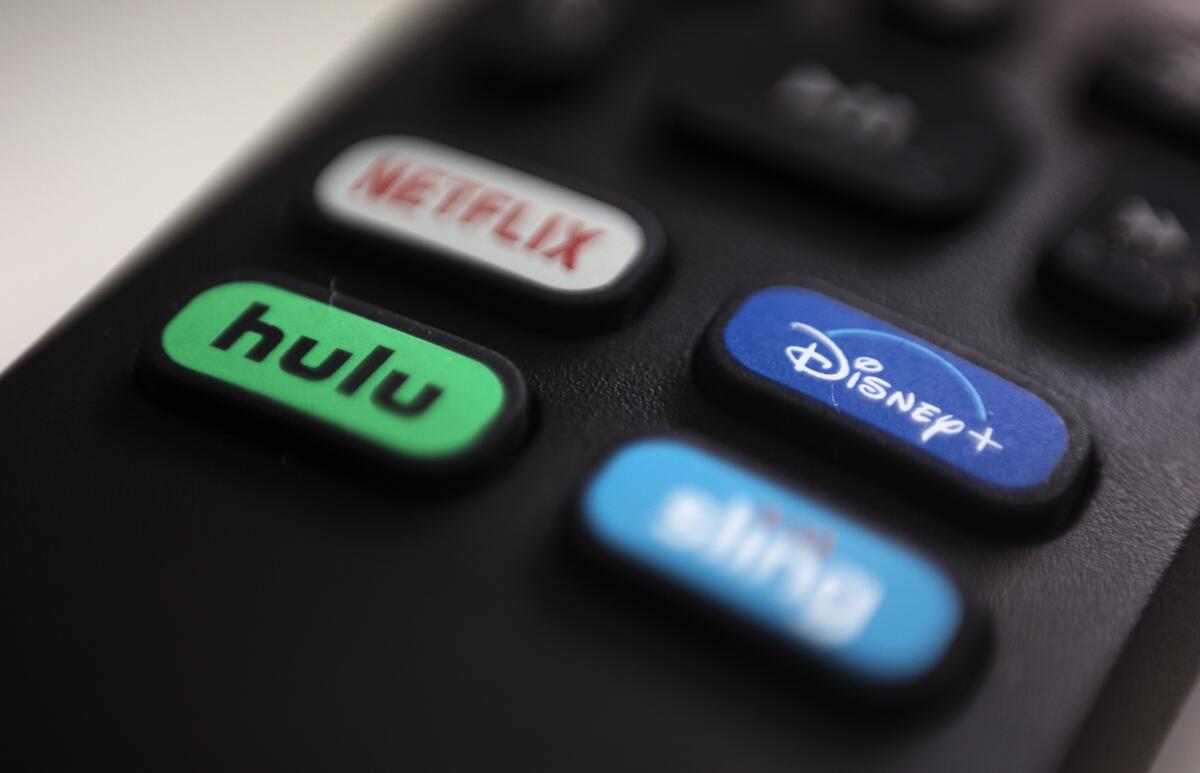Column: As Hulu’s price rises, how much is too much for a streaming service?

- Share via
Disney’s decision this week to raise the price of its Hulu streaming service by $1 isn’t just a money grab, although it’s definitely that. With roughly 43 million paying Hulu subscribers, that’s as much as $43 million a month in extra revenue.
But it’s not just about the money.
Disney, like all the streaming services that now play an outsized role in people’s lives amid the never-ending pandemic, is also testing the waters. It’s trying to determine how much consumers will pay, and for how long, in an increasingly crowded marketplace.
“Every one of these streaming services is competing for our time and wallets,” said Dan Rayburn, a digital-media analyst with the business consulting firm Frost & Sullivan.
“The entire industry is trying to figure out how high it can raise rates before it increases churn,” he told me.
“Churn,” if you’re not familiar with the term, is common to all subscription-based businesses. It’s the volume of turnover in any given month as some people cancel their subscriptions and take their time and wallets elsewhere.
Inside the business of entertainment
The Wide Shot brings you news, analysis and insights on everything from streaming wars to production — and what it all means for the future.
You may occasionally receive promotional content from the Los Angeles Times.
“None of these companies make you sign a contract,” Rayburn observed. “So people can leave any time they want. And they do.”
For consumers, this raises some interesting questions.
How much will most people be willing to pay for a streaming service?
How many services will most people subscribe to?
How does an industry remain solvent when its customers repeatedly cycle from one provider to another?
“These are good questions,” Rayburn said. “We don’t yet know the answers.”
Disney — no slouch when it comes to gauging consumer behavior — is playing things carefully.
The company made an incredibly canny move when it introduced its Disney+ streaming service in 2019 at a bargain-basement price of $6.99 a month — about half what Netflix charged at the time for its standard plan.
That relatively low price attracted millions of subscribers. Then, in March of this year, Disney raised the price by $1 a month, yet still managed to attract more than 12 million new subscribers in the most recent quarter.
The company hasn’t said it will boost the fee for Disney+ again anytime soon, but another increase seems inevitable. Clearly, millions of people still think they’re getting good value for their money.
Disney would be foolish not to test that proposition by seeing how high the price of Disney+ can go before subscribers start heading for the door.
The company is apparently making the same calculation with its ESPN+ streaming service, which last month similarly went up in price by $1 a month.
“I would argue that Disney came out with artificially low prices, especially for Disney+, in order to drive huge subscriber demand, which frankly worked,” said Jeffrey Wlodarczak, a senior analyst at Pivotal Research Group.
“Now they are just starting to normalize their pricing,” he told me.
Every industry analyst I spoke with agreed that things are going to get messy, at least for service providers.
“There will likely be higher churn industrywide for the next year given the enormous investments all are making into content,” said Alexia Quadrani, a media analyst with JPMorgan Chase.
This higher churn will give a better sense of which streaming services are in it for the long haul and which ones may end up as digital roadkill.
“I have no doubt Disney will end up with a seat at the winner’s table,” Quadrani said.
I’d agree with that. Let’s also figure that Netflix will keep its seat, as will Amazon Prime Video and possibly Hulu.
That leaves a whole bunch of streaming services — Apple TV+, HBO Max, Peacock, Paramount+, etc. — jockeying for whatever seats remain.
And don’t forget the music side of things. Spotify, Tidal, Apple Music, Pandora and others also want subscription fees that can run as high as $15 a month.
It’s unclear how many streaming services most people will commit to on an ongoing basis.
A recent J.D. Power survey found that the average American now subscribes to four or five streaming services, up from three at the start of the pandemic. On average, households spend a total of $55 a month, the survey found, or about half the average cable and internet bill.
Rayburn at Frost & Sullivan predicted the average will rise to five or six streaming services per household in coming months, but he said consumers will grow pickier to prevent their entertainment budgets from exploding.
He foresees four tiers of streaming services emerging. At the top of the pecking order in terms of cost will be services offering live TV, such as YouTube TV ($65 monthly), Hulu Plus Live TV ($65) and Sling TV ($35).
Next will come big dogs such as Netflix and HBO Max, running in the $15 range. Then there will be services priced closer to $10 a month, including Amazon, Disney+ and Hulu.
In the bottom tier, Rayburn said, will be smaller, more niche-oriented services such as Crunchyroll ($8) and Acorn TV ($6). Their futures are uncertain.
Let’s say Netflix, Amazon and Disney+ will be on most people’s subscription lists. Let’s also factor in at least one streaming music service. That leaves just one or two openings if most households subscribe to no more than half a dozen services.
Talk about your Darwinian struggles. And I’m not even stirring in newspaper, magazine and other journalism subscriptions, which theoretically are chasing the same dollars.
Prices for streaming services won’t go down anytime soon. As Quadrani noted, it’s now all about who has the most (and best) content, and content is expensive. Higher prices are all but inevitable.
“Raising prices too quickly, or too high, can increase churn, so operators have to be judicious with price hikes,” cautioned Seth Shafer, a media analyst at S&P Global Market Intelligence’s Kagan research group.
“Each service has a different break-even and profitability point, based on content libraries and programming costs,” he said, “so it’s unlikely that the industry will converge to a single price point.”
Most analysts I spoke with believe savvy consumers will get into the habit of subscribing to two or three streaming services, chewing through their libraries of content, and then canceling and signing up for different services.
Or they’ll wait until something they really want to see comes online, subscribe to that service for a month, and then move on.
Shafer said a likely scenario is that many people will maintain Netflix and Amazon as their “anchor services,” and will then rotate through an additional three to five services each month.
Rayburn predicted that, to discourage endless churn, some services may introduce rewards programs that offer discounts or bonus content in return for extended subscriptions.
I agree that rotating services seems like the smart play for consumers. I’ve been doing that for months and it’s worked out just fine. (I don’t think I left any “Star Trek” untouched by the time I decamped from Paramount+.)
I also note that “Dune” is slated to arrive on HBO Max on Oct. 22.
I look forward to being a subscriber next month. And only next month.
More to Read
Inside the business of entertainment
The Wide Shot brings you news, analysis and insights on everything from streaming wars to production — and what it all means for the future.
You may occasionally receive promotional content from the Los Angeles Times.











